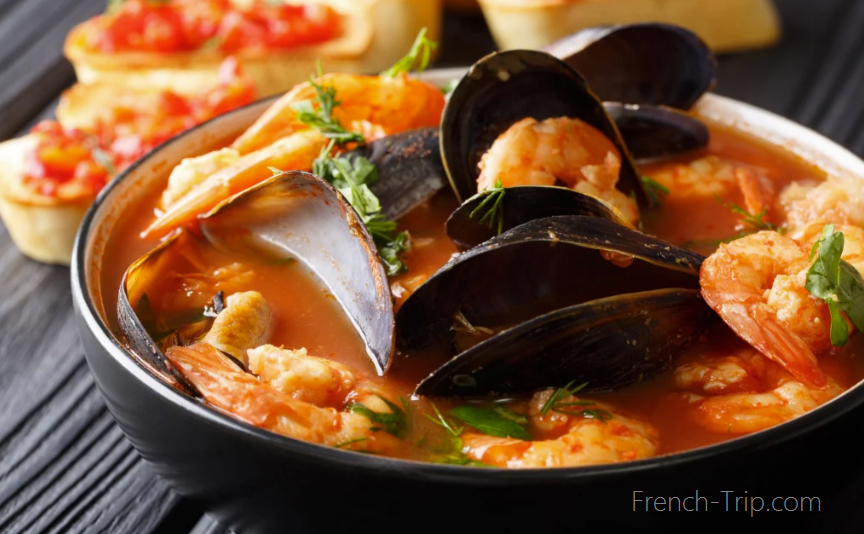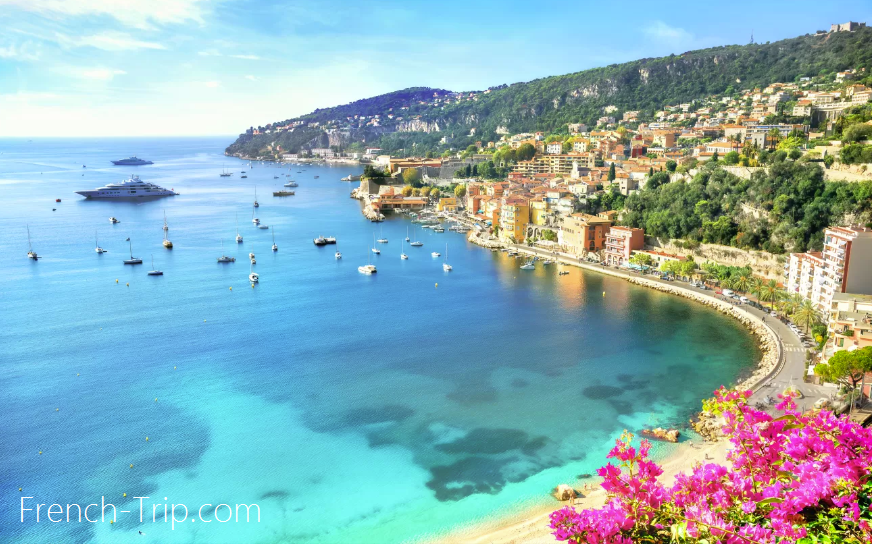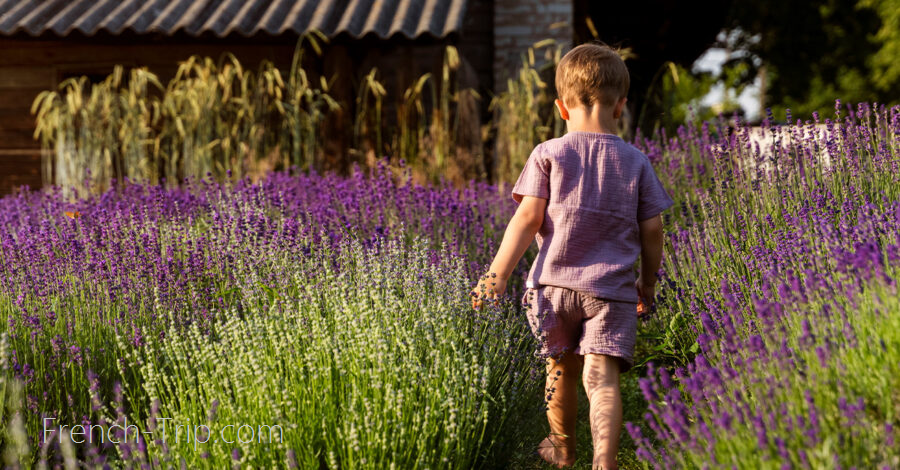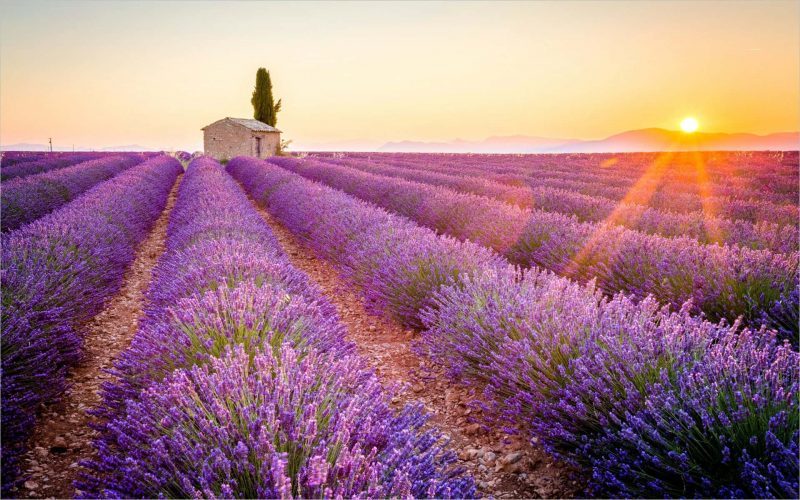Provence-Alpes-Côte d’Azur

Provence-Alpes-Côte d’Azur, often abbreviated as PACA, is a stunning and diverse region in the southeastern part of France that attracts tourists from all over the world. This is one of the most visiting regions in France. Its famous lavender fields became one of the most important symbols of France and its beaches attracted celebrities from all over ther world!
Here, one longs to fully enjoy life, savor all the beauty of nature, soak in the sunshine, and revel in the freshness of cool rosé. Provence is filled with aromas like no other region in France: lavender, rosemary, thyme infuse the warm air and intoxicate the senses. Provence has been an inspiration for countless artists and writers who found their muse in the remarkable light of local landscapes.
In this the most practical Provence guide you will find all necessary information to detailly plan your route and get the most impression!
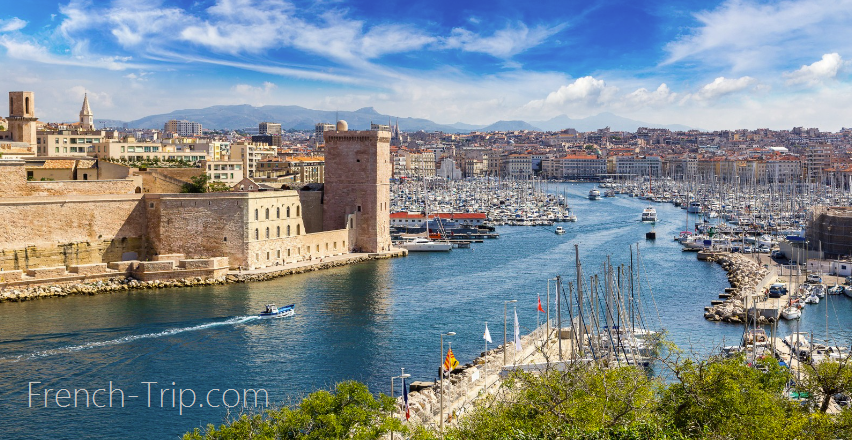
The essense of Provence-Alpes-Côte d’Azur
Provence-Alpes-Côte d’Azur offers a blend of history, culture, natural beauty, and luxury that appeals to a wide range of tourists. Whether you’re interested in exploring ancient Roman sites, relaxing on beautiful beaches, or savoring delicious cuisine, this region has something to offer every traveler.
- Picturesque Villages: Rpovence is known for its charming and picturesque villages. Places like Gordes, Roussillon, and Moustiers-Sainte-Marie are perched on hillsides and feature cobblestone streets, colorful houses, and beautiful views.
- Lavender Fields: Provence is famous for its lavender fields, especially in the Plateau de Valensole area. The lavender blooms in the summer, creating a sea of purple that’s a photographer’s dream.
- Historic Cities: The region boasts historic cities like Avignon, known for the stunning Palais des Papes, and Aix-en-Provence with its beautiful architecture, markets, and fountains.
- Cultural Heritage: region is rich in history and culture. Explore the Roman ruins in Arles, including the Arena and the Roman Theater. Marseille, the region’s largest city, offers a mix of modern and historic attractions.
- Côte d’Azur Beaches: The French Riviera, or Côte d’Azur, is famous for its glamorous beaches and resorts. Cities like Nice, Cannes, and Saint-Tropez are known for their stunning Mediterranean coastline, luxury hotels, and vibrant nightlife.
- Outdoor Activities: The region’s diverse landscapes make it a paradise for outdoor enthusiasts. Hiking in the Calanques near Marseille, cycling through the vineyards of Provence, and skiing in the Southern Alps are popular activities.
- Provincial Cuisine: Enjoy the delicious cuisine of Provence, which features fresh Mediterranean ingredients like olives, olive oil, tomatoes, and herbs. Try traditional dishes like ratatouille and bouillabaisse.
- Wine and Vineyards: Provence is known for its vineyards, particularly in the wine regions of Provence and the Côtes du Rhône. Take wine tours and tastings to sample the local rosé and red wines.
- Art and Culture: The region has a rich artistic heritage. Visit the Fondation Maeght in Saint-Paul-de-Vence for modern art, or explore the works of Vincent van Gogh in Arles.
- Festivals and Events: Provence hosts a wide range of festivals and events throughout the year, celebrating everything from music and film to food and lavender. The Cannes Film Festival and Nice Carnival are among the highlights.
- Natural Beauty: The region is known for its diverse natural beauty, including the Verdon Gorge, one of Europe’s most beautiful canyons, and the Calanques, limestone cliffs along the coast.
- Provencal Markets: Visit vibrant markets like the Cours Saleya in Nice or the L’Isle-sur-la-Sorgue Antique Market for local products, antiques, and artisan crafts.
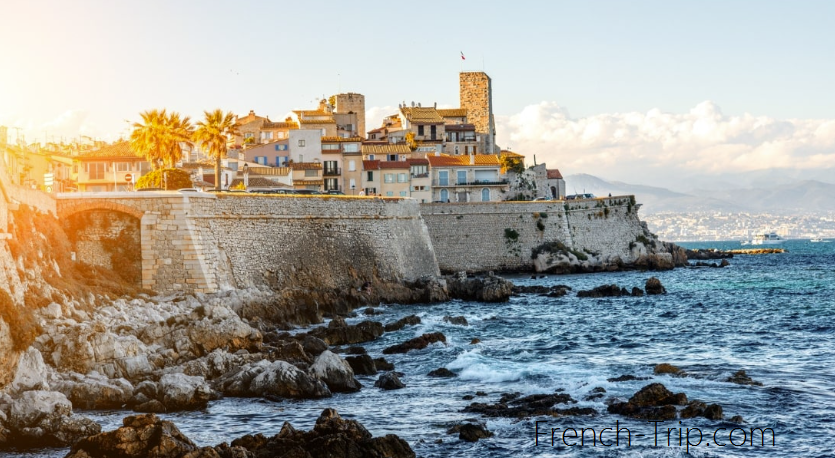
Most important places to visit in Provence:
- Marseille: The largest city in the region, Marseille is a bustling port city with a rich history, vibrant markets, and a picturesque Old Port (Vieux-Port).
- Aix-en-Provence: Known for its elegant architecture, historic old town, and Cours Mirabeau, Aix-en-Provence is a cultural and artistic hub.
- Avignon: Famous for the Palais des Papes (Palace of the Popes) and the Pont Saint-Bénézet (Pont d’Avignon), Avignon is a city steeped in history.
- Nice: Located on the French Riviera, Nice boasts beautiful beaches, a charming Old Town (Vieux Nice), and the stunning Promenade des Anglais.
- Cannes: Known for its glamorous film festival, Cannes offers upscale shopping, beautiful beaches, and the historic Le Suquet district.
- Saint-Tropez: A glamorous seaside town, Saint-Tropez is famous for its nightlife, luxury yachts, and beautiful beaches.
- Arles: This historic town is famous for its well-preserved Roman architecture, including the Roman Arena and the Alyscamps necropolis.
- Grasse: Renowned as the perfume capital of the world, Grasse offers perfume workshops and stunning views from the Old Town.
- Gordes: Perched on a hilltop in the Luberon region, Gordes is a beautiful village with stone houses and panoramic views.
- Moustiers-Sainte-Marie: Known for its picturesque setting near the Gorges du Verdon and its ceramic craftsmanship.
- Villefranche-sur-Mer: A charming coastal town with colorful buildings and a scenic bay, located near Nice and Monaco.
- Cassis: A picturesque fishing village known for its calanques (inlets), crystal-clear waters, and Mediterranean charm.
- Vence: Famous for its Chapelle du Rosaire (Matisse Chapel) and its medieval Old Town.
- Sisteron: A historic town on the Route Napoléon with a citadel overlooking the Durance River.
- Eze: Perched on a hilltop, Eze offers stunning views of the Mediterranean and is known for its exotic gardens.
- Roussillon: Known for its red and ochre cliffs, Roussillon is a charming village in the Luberon with colorful buildings.
- Cotignac: A picturesque village with a backdrop of cliffs and caves, known for its terraced houses.
- Séguret: A medieval village in the Vaucluse with narrow streets, stone houses, and beautiful vineyards.
- Bormes-les-Mimosas: Famous for its vibrant mimosa trees, Bormes-les-Mimosas is a floral delight in the Var department.
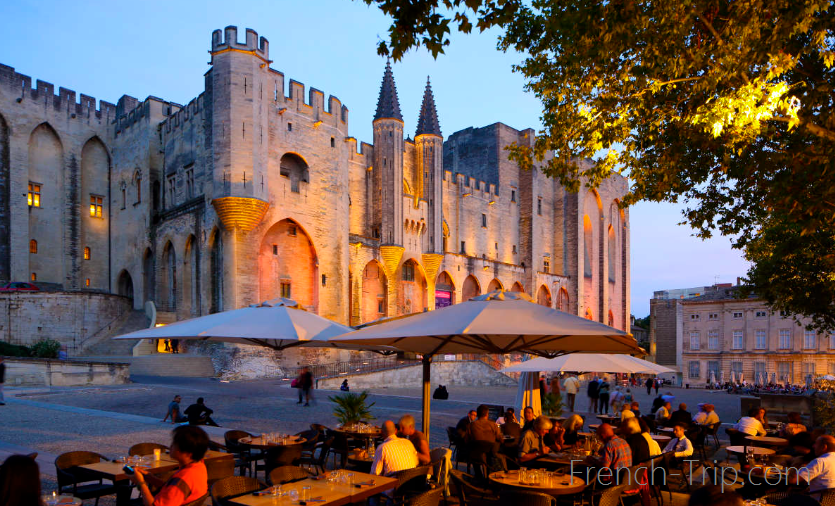
Avignon
Nature sights to visit in Provence
Provence boasts a wealth of natural wonders, making it a paradise for nature enthusiasts. The Verdon Gorge, often referred to as the “Grand Canyon of Europe,” is a must-visit, offering dramatic limestone cliffs and turquoise waters perfect for hiking, kayaking, and admiring breathtaking scenery. The Calanques near Marseille present a unique blend of rugged coastal landscapes, limestone fjords, and crystal-clear Mediterranean waters, ideal for hiking and swimming. For lavender lovers, the Plateau de Valensole showcases endless fields of fragrant lavender in full bloom during the summer. And the Camargue, a vast wetland, is a birdwatcher’s paradise, home to flamingos and wild horses.
These natural wonders, among many others, make Provence a haven for outdoor exploration and appreciation of the region’s diverse landscapes. Read more…
Most beautiful villages in Provence:
- Gordes: Perched on a hilltop in the Luberon Regional Park, Gordes is often considered one of the most beautiful villages in France. Its stone houses and stunning views of the surrounding countryside make it a popular destination.
- Roussillon: Known for its distinctive red and ochre cliffs and buildings, Roussillon is a colorful village located in the Luberon. It’s a delight to explore its narrow streets and admire the vibrant scenery.
- Moustiers-Sainte-Marie: Nestled in a rocky gorge near the Verdon Gorge, this village is known for its star-shaped bridge and charming setting. It’s often called one of the most beautiful villages in Provence.
- L’Isle-sur-la-Sorgue: Dubbed the “Venice of Provence” for its canals and waterwheels, this village is famous for its antique markets and charming ambiance.
- Saint-Paul-de-Vence: This medieval village is renowned for its art galleries, cobbled streets, and stunning views of the surrounding landscape. It has a long history as an artistic hub.
- Eze: Perched high on a hill overlooking the Mediterranean, Eze is a medieval village with narrow streets, gardens, and breathtaking views of the French Riviera.
- Bonnieux: Located in the Luberon, Bonnieux offers panoramic views from its hillside location. Its charming streets are lined with shops, cafes, and historical sites.
- Gourdon: High on a rocky spur, Gourdon offers sweeping views of the countryside and the Mediterranean below. The village is known for its well-preserved medieval architecture.
- Ansouis: This small village is known for its medieval castle and well-preserved historic center. It’s a peaceful and beautiful place to explore.
- Seillans: Situated in the Var department, Seillans is a charming village with stone houses and a picturesque square. It’s often considered one of the prettiest villages in the Var.
- Les Baux-de-Provence: Perched atop a rocky plateau, this village is known for its medieval fortress ruins and stunning views of the Alpilles mountains.
- Venasque: A tiny village with a Romanesque church and medieval architecture, Venasque offers a glimpse into Provence’s past.
- Lacoste: This village is known for its picturesque ruins of a castle once owned by the infamous Marquis de Sade. It offers a unique blend of history and beauty.
- Valensole: While technically a town, Valensole is famous for its lavender fields, particularly in July when they are in full bloom. The vibrant purple landscapes are a sight to behold.
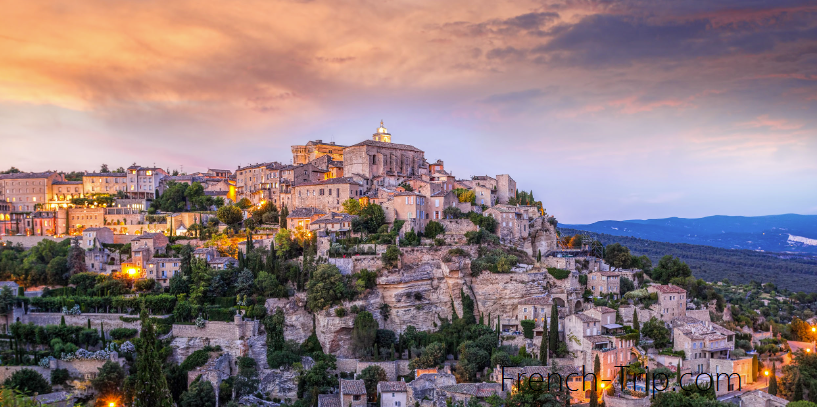
Gordes, Provence
Shopping in Provence
Shopping in Provence is a delightful experience, offering a wide range of unique products and local specialties. The region is known for its vibrant markets, where you can immerse yourself in the Provençal way of life and discover an array of goods.
Provence is famous for its colorful outdoor Provençal Markets, or “marchés,” which are held regularly in towns and villages throughout the region. These markets are a feast for the senses, featuring fresh produce, local cheeses, olives, spices, herbs, flowers, and artisanal products. You can find markets specializing in everything from food to antiques and crafts.
More information:
Cuisine Provençal
The cuisine of Provence-Alpes-Côte d’Azur is a delightful reflection of the region’s Mediterranean climate and culture. It incorporates fresh, locally sourced ingredients, aromatic herbs, and a rich tradition influenced by both French and Mediterranean culinary styles. Key elements and dishes that define Provençal cuisine include olive oil, herbs (particularly lavender and thyme), and garlic, which play a pivotal role in shaping the region’s flavor profile. Provençal cuisine is anchored in the use of fresh vegetables, olives, and seafood, and these ingredients harmoniously pair with the renowned local wines, as Provence is one of France’s famous wine regions.
Provencal wines
Provence-Alpes-Côte d’Azur (PACA) is a region known for producing some excellent wines, particularly in the wine-producing area of Provence. Nice is part of one of France’s important wine regions – Côtes de Provence AOC. It accounts for 3/4 of all Provencal wines and offers a variety of grape varieties. The vast majority of local wines are rosé, which have built the reputation of Provencal wines. Delicate and refreshing, they complement traditional Provencal dishes perfectly! In the region, they even have a tourist wine route – the Route des Vins des Côtes de Provence.

When to visit Provence?
The ideal time to visit Provence varies with the seasons, offering something special throughout the year. Spring, from April to June, blankets the region in vibrant colors with blooming lavender and wildflowers. Summer, from June to August, boasts warm Mediterranean weather, making it perfect for beach outings and lively festivals. Autumn, in September and October, brings a pleasant climate, ideal for vineyard tours and enjoying the harvest season. Winter, from November to March, offers a quieter, more serene experience with the chance to explore historic sites without the summer crowds, but keep in mind that some attractions may have reduced hours or seasonal closures. Read more…
Transport in Provence
Provence-Alpes-Côte d’Azur boasts a well-developed transportation network, making it convenient for tourists to explore the region without the need for a rental car. However, some smaller villages may only be accessible by public transport during the high season. Due to the region’s hilly terrain and the influx of visitors in July and August, traffic along the coastline can become congested, so it’s worth reconsidering the use of a car, especially near the seashore.
- Trains: The French railway network, operated by SNCF, serves many cities and towns in PACA. Major cities like Marseille, Nice, and Avignon have well-connected train stations. The high-speed TGV (Train à Grande Vitesse) connects the region to other major French cities and European destinations.
- Buses and Trams: Many cities in PACA, including Marseille, Nice, and Toulon, have extensive bus and tram networks. These are convenient for getting around within cities and accessing nearby towns.
- Regional Trains: The TER (Transport Express Régional) network connects smaller towns and villages within the region. It’s a cost-effective way to explore the countryside and visit picturesque villages.
- Taxis: Taxis are readily available in urban areas and at transportation hubs. They can be a convenient way to reach your destination, but they tend to be more expensive than public transportation.
- Car Rentals: Renting a car is a popular option for exploring the more remote areas of PACA, especially if you want to visit small villages or natural attractions in the countryside. Rental agencies can be found at major airports and train stations.
- Cycling: PACA offers beautiful landscapes for cycling enthusiasts. Many cities have dedicated bike lanes, and there are scenic routes in the countryside. Some cities also have bike-sharing programs.
- Ferries: Given its proximity to the Mediterranean Sea, some coastal cities like Marseille and Nice have ferry services to nearby islands and other Mediterranean destinations.
- Airports: PACA is served by several airports, with Nice Côte d’Azur Airport being the largest and most well-connected. Marseille Provence Airport and Toulon-Hyères Airport are also significant transportation hubs. These airports offer domestic and international flights, making it easy to access the region by air.
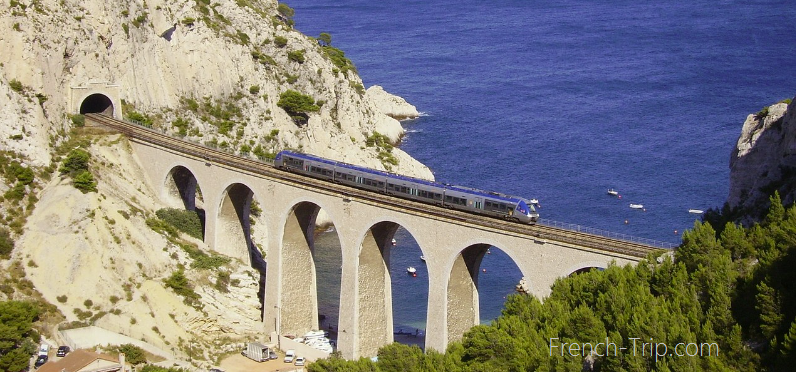
Best beaches in Provence-Alpes-Côte d’Azur
Provence-Alpes-Côte d’Azur is renowned for its beautiful Mediterranean coastline, which offers a variety of beaches to suit different preferences. But pay attention: the most beautiful beaches in Provence are either paid (25 – 45 € per person in high season) or far away and not reachable without car (means + parking costs). As a result, just wrong location may increase your travel costs significantly. That is why it is very important to double check before travelling whether you have free beaches nearby.
Provence with kids
Provence-Alpes-Côte d’Azur is a fantastic destination for family travel, offering a diverse range of activities and attractions that cater to children of all ages. From the stunning beaches of the French Riviera to charming hilltop villages and beautiful natural landscapes, Provence provides a mix of adventure, culture, and relaxation. Kids can explore historical sites, discover local traditions in markets and festivals, and enjoy outdoor adventures such as hiking, biking, and water sports. The region’s rich history, vibrant culture, and delicious cuisine create a memorable experience for families. Whether it’s building sandcastles on Mediterranean beaches, exploring ancient castles, or savoring delicious Provencal ice cream, Provence ensures a delightful family vacation with lasting memories. Read more…
Pros and Contras to visit Provence
While Provence-Alpes-Côte d’Azur (PACA) is a beautiful and vibrant region with much to offer, like any destination, it has its drawbacks and challenges. Here are some negative aspects to consider when planning a visit to PACA:
- Crowds and High Season Prices: During the summer months, PACA can be extremely crowded, especially in popular coastal towns like Nice and Saint-Tropez. Accommodation prices tend to rise significantly during this period, making it less budget-friendly.
- Traffic and Parking: Traffic congestion can be a problem in major cities like Marseille and Nice, particularly during the tourist season. Finding parking can also be challenging in some areas, and parking fees can be steep.
- Cost of Living: The cost of living in PACA, particularly in the Côte d’Azur region, can be high, which can impact the overall expense of your trip, from dining out to accommodation.
- Mistral Wind: The Mistral, a strong, cold wind that blows through the Rhône Valley and into PACA, can be fierce, especially during the winter months. It can be uncomfortable for outdoor activities and may disrupt travel plans.
- Summer Heat: While many people enjoy the warm Mediterranean climate of PACA, the summer heat can be intense, with temperatures often exceeding 30°C (86°F) and occasionally reaching 35°C (95°F) or higher. This can be uncomfortable for some travelers, especially those who are sensitive to heat.
- Lack of Accessibility: While efforts have been made to improve accessibility, some areas and attractions may still lack the necessary infrastructure for travelers with disabilities.
- Scams and Petty Crime: Like in many tourist destinations, there can be scams and instances of petty crime, particularly in crowded areas. Be cautious and vigilant, especially in busy tourist spots.
Despite these potential drawbacks, Provence remains a popular and beloved destination for its stunning landscapes, rich culture, and diverse attractions.
What to do in Provence
Provence-Alpes-Côte d’Azur, invites you to embark on a diverse and unforgettable journey. Beyond its renowned lavender fields and Mediterranean beaches, you can explore the Verdon gorges by paddleboard, visit rustic vineyards tucked away in the hills, and wander through charming hilltop villages like Gordes, seemingly frozen in time.
Don’t miss the opportunity to delve into artistic history at the Arles Amphitheatre, where Van Gogh once roamed, or navigate the enchanting Calanques National Park by kayak. Whether you’re dining on fresh seafood in Marseille‘s Old Port or witnessing the breathtaking lavender bloom in Valensole, Provence offers a wealth of unique experiences waiting to be discovered. Read more…
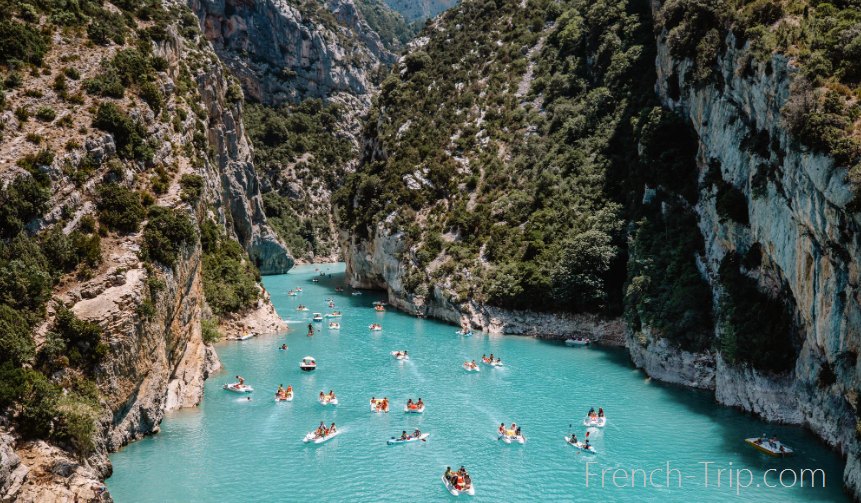
Famous guests in Provence
Provence has been home to many famous individuals throughout history in various fields, including art, literature, music, and politics. Here are some of the most notable citizens associated with the region:
- Paul Cézanne (1839-1906): Born in Aix-en-Provence, Cézanne is one of the most influential post-impressionist painters in the history of art. He is known for his innovative approach to color and form and is often referred to as the “father of modern art.”
- Vincent van Gogh (1853-1890): Although not born in Provence, Vincent van Gogh spent a significant part of his life in Arles, where he created some of his most iconic paintings, such as “Starry Night Over the Rhône” and “Café Terrace at Night.”
- Frédéric Mistral (1830-1914): A Nobel Prize-winning poet and writer, Frédéric Mistral was born in Maillane, a village in Provence. He is best known for his work in the Provençal language and his contributions to the preservation of Provençal culture.
- Édith Piaf (1915-1963): Although she was born in Paris, the iconic French singer Édith Piaf spent part of her childhood in the Côte d’Azur region, notably in Cannes and Nice.
- Alphonse Daudet (1840-1897): The acclaimed French novelist and author of works like “Letters from My Windmill” spent time in the region and drew inspiration from its landscapes and culture.
- Simone de Beauvoir (1908-1986): The prominent French existentialist philosopher and feminist writer, known for her influential book “The Second Sex,” lived in Provence at various points in her life.
- Marc Chagall (1887-1985): The Russian-French artist Marc Chagall spent a considerable part of his life in the town of Saint-Paul-de-Vence in PACA. The region’s colors and landscapes influenced his work significantly.
- Albert Camus (1913-1960): The philosopher and author of “The Stranger” was born in French Algeria but lived in Lourmarin, a village in Provence, where he wrote several of his famous works.
- René Goscinny (1926-1977): The co-creator of the beloved “Asterix” comic book series was born in Paris but had strong ties to the region, particularly in Nice, where he lived and worked.

a list of famous painters who either lived or spent significant time visiting Provence, along with details about where they stayed or lived and what they painted:
- Vincent van Gogh: Van Gogh lived in Arles and Saint-Rémy-de-Provence. During his time in Provence, he created some of his most iconic works, including “Starry Night Over the Rhône” and “The Bedroom.”
- Paul Cézanne: Born in Aix-en-Provence, Cézanne is closely associated with the region. He painted numerous landscapes of Provence, such as “Mont Sainte-Victoire” and “The Bathers.”
- Pierre-Auguste Renoir: Renoir spent time in Cagnes-sur-Mer on the French Riviera. He painted scenes of everyday life, portraits, and landscapes in the region.
- Henri Matisse: Matisse lived in the town of Nice, Provence, for much of his life, settling there in 1917. During his time in Provence, Matisse created some of his most famous paintings, including vivid interiors, still lifes, and landscapes that captured the essence of the Mediterranean.
- Raoul Dufy: Dufy, a Fauvist painter, captured scenes from the French Riviera, including Nice and Antibes. His colorful works often depict leisure and celebrations.
- Marc Chagall: Though not originally from Provence, Chagall lived and worked in Saint-Paul-de-Vence, creating dreamlike and imaginative pieces.
- Georges Braque: Braque, a Cubist painter, lived in Varengeville-sur-Mer in Normandy but also spent time in the South of France. His works reflect Cubist and Fauvist influences.
- Jean-Michel Basquiat: Basquiat visited Arles and was influenced by van Gogh’s work, incorporating elements into his own unique style.
These painters left an indelible mark on the art world, each contributing their unique style and interpretations of Provence’s landscapes, people, and culture.
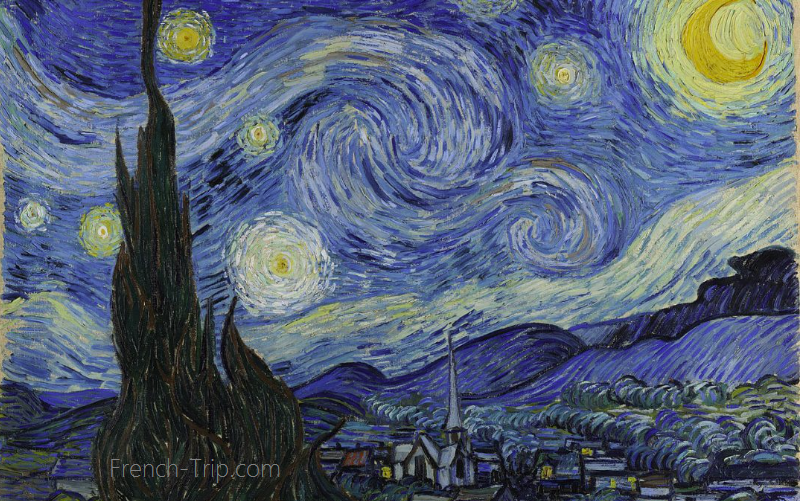
Festivals and Carnivals in Provence
Provence, nestled in the southeastern part of France, is not only famous for its stunning landscapes and Mediterranean beauty but also for its vibrant cultural scene. Throughout the year, Provence comes alive with a wide range of festivals that celebrate its rich heritage, traditions, and artistic prowess. These festivals offer visitors a unique opportunity to immerse themselves in the region’s history, gastronomy, and artistry. From lavender festivals to bull runs, here’s a glimpse into the captivating world of Provencal festivals. Read more…

Lavender fields in Provence
Lavender fields in Provence-Alpes-Côte d’Azur are one of the region’s most iconic and picturesque attractions. The sight and scent of endless lavender fields in full bloom are a quintessential part of the Provencal landscape. The best time to visit lavender fields in Provence is typically from late June through early August, with the peak bloom occurring in July.
Where to Find Lavender Fields:
- Plateau de Valensole: This is one of the most famous and popular areas to see lavender fields. Located near the town of Valensole, the plateau offers expansive fields of lavender and is a photographer’s dream. Some recommended spots include Valensole itself, Puimoisson, and Riez.
- Sault: Sault, located in the Vaucluse department, is another well-known lavender-growing region. The lavender fields around Sault offer stunning vistas, especially when combined with the nearby Gorges de la Nesque.
- Luberon: The Luberon region, encompassing towns like Gordes and Roussillon, is dotted with lavender fields amid its picturesque villages and landscapes.
- Alpes-de-Haute-Provence: Lavender fields are found throughout this department, with some beautiful areas near towns like Digne-les-Bains and Sisteron.
- Drôme Provençale: While not in the Provence region, the neighboring Drôme Provençale area is known for its lavender fields as well, particularly around the town of Nyons.
Tourist routes in Provence-Alpes-Côte d’Azur
Provence-Alpes-Côte d’Azur is a diverse and picturesque region in southeastern France, known for its stunning landscapes, charming towns, and vibrant cities. Here are some popular tourist routes and itineraries to explore:
- The Lavender Route (Route de la Lavande): This route takes you through the lavender fields of Provence, offering breathtaking views and the opportunity to visit charming villages like Sault, Valensole, and Gordes. The best time to experience the lavender in full bloom is from June to August.
- French Riviera Road Trip: Explore the glamorous French Riviera (Côte d’Azur) by taking a road trip along the coast. Start in Nice and make your way to Cannes, Antibes, Saint-Tropez, and Monaco. Along the way, enjoy beautiful beaches, luxury resorts, and historic sites.
- Verdon Gorge Circuit: Known as the “Grand Canyon of Europe,” the Verdon Gorge is a stunning natural wonder. Drive or hike around the gorge, visit the turquoise waters of Lake Sainte-Croix, and enjoy outdoor activities like kayaking and rock climbing.
- Wine Route in Provence: Discover the wine regions of Provence by following a wine route. Explore vineyards and wineries in appellations like Côtes de Provence, Bandol, and Châteauneuf-du-Pape, and enjoy wine tastings and cellar tours.
- Alpine Adventure: Head to the Alpine region of PACA, where you can explore the picturesque villages of the Alpes-de-Haute-Provence, go hiking or skiing in the Southern Alps, and visit towns like Barcelonnette and Gap.
- Medieval Villages of the Luberon: Explore the Luberon Regional Natural Park and its enchanting medieval villages, including Gordes, Roussillon, and Bonnieux. The area is known for its stunning landscapes and historic architecture.
- Cultural Heritage Route: Discover the rich cultural heritage of Provence by visiting cities like Avignon with its famous Palais des Papes, Arles with its Roman heritage, and Aix-en-Provence with its artistic and historical treasures.
- Calanques Coastal Route: Explore the rugged coastline of the Calanques National Park near Marseille. Hike or take a boat tour to discover the stunning limestone cliffs, crystal-clear waters, and hidden coves.
- Artists’ Route in Nice: Follow in the footsteps of famous artists like Matisse and Chagall in Nice. Visit the Matisse Museum, Chagall National Museum, and explore the Old Town (Vieux Nice) for artistic inspiration.
- Roman Provence Route: Explore the Roman heritage of Provence by visiting well-preserved sites like the Roman Theater in Orange, the Pont du Gard aqueduct, and the Roman ruins in Saint-Rémy-de-Provence.
- Haute-Provence Geopark: Discover the geological wonders of the Haute-Provence Geopark, which includes unique landscapes, fossils, and geological formations. Don’t miss the Réserve Géologique de Haute-Provence.
- Biking the Véloroute du Calavon: This scenic bike route takes you through the Luberon region, passing by picturesque villages, lavender fields, and vineyards.
Best provencal wines
The Provence wine region in France, known for its beautiful vineyards and Mediterranean climate, offers several wine routes that allow visitors to explore the diverse wines produced in the area. The wines of Provence, including those with the Provence AOC (Appellation d’Origine Contrôlée) designation, are renowned for their rosés, but the region also produces red and white wines.
- Côtes de Provence Wine Route:
- Details: The Côtes de Provence AOC is the largest appellation in Provence, famous for its rosé wines, but it also produces red and white wines.
- Suggested Route: Begin your journey in the town of Draguignan, then follow the D557 and D562 roads to explore vineyards and wineries in the Massif des Maures and the Var region. Don’t miss the picturesque village of La Garde-Freinet.
- Coteaux d’Aix-en-Provence Wine Route:
- Details: Coteaux d’Aix-en-Provence AOC is known for its red, white, and rosé wines. The vineyards are situated in the western part of Provence.
- Suggested Route: Start in Aix-en-Provence and take the D64 and D17 roads to explore the vineyards around the city. Consider visiting Château de Beaulieu or Château Vignelaure for wine tasting.
- Coteaux Varois en Provence Wine Route:
- Details: This AOC produces a variety of wines, including rosés, reds, and whites. It’s located in the Var department.
- Suggested Route: Begin in the town of Brignoles and follow the D45 and D554 roads to discover wineries in the Coteaux Varois en Provence region. The town of Cotignac is a charming stop along the way.
- Bandol Wine Route:
- Details: Bandol AOC is famous for its bold and flavorful red wines made primarily from Mourvèdre grapes. It’s situated on the Mediterranean coast.
- Suggested Route: Start in the coastal town of Bandol and take the scenic Route des Vins de Bandol (D559) to visit renowned wineries such as Domaine Tempier and Domaine Ott.
- Les Baux-de-Provence Wine Route:
- Details: Les Baux-de-Provence AOC is known for its unique wines produced in the Alpilles mountains.
- Suggested Route: Begin in the charming village of Les Baux-de-Provence and explore the surrounding vineyards. Consider visiting Château Romanin, a biodynamic winery.
What to visit?
- Marseille – France’s second largest city and major port
- Nice – Glamorous city on the French Riviera
- Cannes – Famous for its film festival
- Saint-Tropez – Chic coastal resort town
- Aix-en-Provence – Elegant university town
- Avignon – Historic city with Papal Palace
- Arles – Town known for Roman ruins and Van Gogh
- Gordes – Beautiful hilltop village in the Luberon
- Roussillon – Village famous for its ochre cliffs
- Les Baux-de-Provence – Medieval village with castle ruins
- Cassis – Charming fishing port near Marseille
- Calanques National Park – Stunning coastal cliffs and coves
- Verdon Gorge – Europe’s “Grand Canyon”
- Luberon Regional Nature Park – Picturesque landscapes and villages
- Camargue – Unique wetlands with wild horses and flamingos
- Mont Ventoux – Famous mountain in Provence
- Porquerolles Island – Beautiful car-free island
- Saint-Paul-de-Vence – Medieval hilltop village popular with artists
- Antibes – Coastal town with Picasso museum
- Menton – Colorful town on Italian border
- Grasse – World perfume capital
- Eze – Perched village with exotic gardens
- Cotignac – Village with troglodyte dwellings
- Gassin – Village with panoramic views of Saint-Tropez bay
- Lourmarin – Charming village in the Luberon
Town and villages in Provence-Alpes-Côte d’Azur
- Aix-en-Provence
- Ansouis
- Arles
- Avignon
- Bandol
- Bonnieux
- Carpentras
- Cassis
- Châteauneuf-du-Pape
- Cucuron
- Draguignan
- Eze
- Fontaine-de-Vaucluse
- Forcalquier
- Gordes
- Grasse
- Gémenos
- L’Isle-sur-la-Sorgue
- La Ciotat
- Le Beausset
- Le Lavandou
- Les Baux-de-Provence
- Lorgues
- Luberon
- Manosque
- Marseille
- Moustiers-Sainte-Marie
- Nice
- Nyons
- Orange
- Pertuis
- Roussillon
- Saint-Paul-de-Vence
- Saint-Rémy-de-Provence
- Saint-Tropez
- Salon-de-Provence
- Sault
- Sisteron
- Tourtour
- Toulon
- Vaison-la-Romaine
- Valensole
- Villefranche-sur-Mer
- Villeneuve-Loubet
- Villes-sur-Auzon
- Aups
- Bormes-les-Mimosas
- Gassin
- L’Isle-sur-la-Sorgue
- Lourmarin
- Martigues
- Miramas-le-Vieux
- Mont Ventoux
- Mouans-Sartoux
- Ramatuelle
- Rians
- Riez
- Roquebrune-sur-Argens
- Sillans-la-Cascade
- Vence
- Venasque
- Fayence
- Fontvieille
- Pernes-les-Fontaines
- Port Grimaud
- Saintes-Maries-de-la-Mer*
- Senanque Abbey*
- Sénas*
Archives
Calendar
| M | T | W | T | F | S | S |
|---|---|---|---|---|---|---|
| 1 | 2 | 3 | 4 | 5 | 6 | 7 |
| 8 | 9 | 10 | 11 | 12 | 13 | 14 |
| 15 | 16 | 17 | 18 | 19 | 20 | 21 |
| 22 | 23 | 24 | 25 | 26 | 27 | 28 |
| 29 | 30 | 31 | ||||

